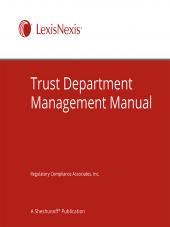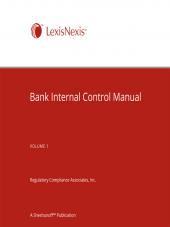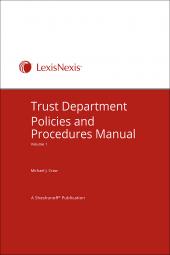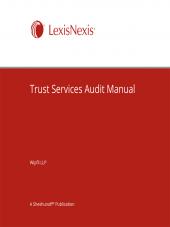Trust Department Management Manual
Select a format
 International Order Inquiry
International Order Inquiry
Select subscription type
Terms & conditions
Subscribers receive the product(s) listed on the Order Form and any Updates made available during the annual subscription period. Shipping and handling fees are not included in the annual price.
Subscribers are advised of the number of Updates that were made to the particular publication the prior year. The number of Updates may vary due to developments in the law and other publishing issues, but subscribers may use this as a rough estimate of future shipments. Subscribers may call Customer Support at 800-833-9844 for additional information.
Subscribers may cancel this subscription by: calling Customer Support at 800-833-9844; emailing customer.support@lexisnexis.com; or returning the invoice marked "CANCEL".
If subscribers cancel within 30 days after the product is ordered or received and return the product at their expense, then they will receive a full credit of the price for the annual subscription.
If subscribers cancel between 31 and 60 days after the invoice date and return the product at their expense, then they will receive a 5/6th credit of the price for the annual subscription. No credit will be given for cancellations more than 60 days after the invoice date. To receive any credit, subscriber must return all product(s) shipped during the year at their expense within the applicable cancellation period listed above.
The total price includes the product(s) listed in the Order Form and any Updates for a limited period (minimum period of 30 days) after the order is placed ("Order Window"). Shipping and handling fees are not included in the grand total price.
All shipments may be returned, at subscribers' expense, for full credit of the Price within 30 days of receipt.
Shipments may not be returned, and no credits will be issued, more than 30 days after receipt.
After the Order Window, subscribers will receive notice of Updates along with the then-current grand total price and order process as Updates become available. Subscribers will only be shipped those Updates they specifically request.
Product description
View a sample of this title using the ReadNow feature
In the face of the growing competition for trust services, trust department managers need to focus attention and resources on making money. The Sheshunoff® Trust Department Management Manual provides clear guidelines, step-by-step explanations, and time-tested techniques and methods to help trust managers run a more profitable and competitive business.
Sixteen comprehensive chapters cover everything the manager and staff need, from identifying new customers to implementing investment strategies. Coverage includes:
• Where to find new markets and how to reach them
• How to evaluate new products for profit potential before committing resources
• Where technology and automation can really save time and money, and mitigate risk
• How to offer new services without legal and regulatory risk
• How to apply the regulations to day-to-day activities in a format that the entire staff can use
• How proper departmental structure can support management and ensure strategic objectives are met
The Sheshunoff® Trust Department Management Manual isn’t an academic treatise. It’s a proven, practical approach to managing costs, improving profits, and staying competitive. The service provides updates and essential, customizable tools — including an extensive collection of Internal Control Questionnaires — for easy implementation of the trust department management program.
Subscribers will receive a downloadable exe file containing editable forms.
eBooks, CDs, downloadable content, and software purchases are noncancelable, nonrefundable and nonreturnable. Click here for more information about LexisNexis eBooks. The eBook versions of this title may feature links to Lexis+® for further legal research options. A valid subscription to Lexis+® is required to access this content.
Table of contents
Chapter 1 Setting Trust Department Objectives and Organization
Determining Objectives
Strategic and Tactical Initiatives
Organizational Issues and Structure
Profitability
Restructuring
Managing Trust Matters
Vendor Management and Third-Party Risk Profile
Chapter 2 Identifying Potential Trust Services Markets
Regional Market Potential
International Market Potential
Customer Base
The Competition
Dynamics of the Local Economy
External Environment: Implications for the Trust Department
Tips and Insights
A Case Study: Potential for Trust Markets in Arizona
Chapter 3 Administering Personal Trusts
The Essence of Trust Administration
Preparation for Administration
Administrative Policies Decision Making and Recordkeeping in the Trust Department
The Leadership and Coordination Role of the Trust Administrator
Distinctions Between Estate and Personal Trust Administration
Estate Administration
Trust Administration
Custody Administration
Businesses in Trust
Recognizing Liability Factors
Trust Administration Profitability Cost Accounting
Administrative Considerations
Decedent Estates
Guardianships
Agency Accounts
Chapter 3A: Personal Fiduciary Services
Fiduciary Accounts
Powers and Duties of a Trustee
Risk
Supervisions of Fiduciary Services
Laws and Regulations
Uniform Trust Laws
Appendix 3A.A: Fiduciary Activities of National Banks 12 CFR Part 9
Appendix 3A.B: Personal Fiduciary Services — Types of Personal Trusts
Appendix 3A.C: Comptroller’s Handbook Booklets
Chapter 4: Administering Employee Benefit Accounts
Defining the Target Market
Accepting and Establishing an Employee Benefit Account
Administrative Policy
Role of Account Administrator
Developing a Relationship with the Employee Benefit Client
Distinguishing Between Various Employee Benefit Plans
Administering Defined Benefit Plans
Administering Defined Contribution Plans
Administering IRAs, Prototype Plans, Welfare Benefit Plans, Nonqualified Plans, and Master Trusts
Inheritance Tax Waivers
Recognizing Fiduciary Responsibilities
Employee Benefit Administration Profitability
Administrative Safeguards
Small Business Jobs Protection Act of 1996
Specific Employee Benefit Account Administration Safeguards
Written Procedures
ERISA — Investment Issues
Appendix 4A: Sample Participant Loan Policies and Procedures
Appendix 4B: U.S. Department of Labor Field Assistance Bulletin 2002-3
Chapter 4A: Securities Lending
Anatomy of a Loan
The Lender
The Borrower
The Intermediary
Going It Alone
Risk Management
Laws and Regulations
Appendix 4A.A: Securities Lending Risk Control Checklist
Appendix 4A.B: Regulation T — Part 220 Section 220.10
Appendix 4A.C: Securities Exchange Act of 1934 Rule 15c3-3 Customer Protection —
Reserves and Custody of Securities
Appendix 4A.D: ERISA PTE 81-6 Involving Lending of Securities by Employee Benefit Plans
Chapter 4B: Custody Services
The Custody Services Industry
Board and Management Supervision
Global Sub-Custodian Network
Safekeeping and Settlement
Securities Servicing
Securities Lending
Other Value-Added Custody Services
Banks as Users of Custody Services
Document Custody Services
Risk Management
Laws and Regulations
Appendixes
Appendix 4B.A: Summary of Key Internal Controls
Appendix 4B.B: Custody Services Laws and Regulations
Appendix 4B.C: Rules and Regulations Investment Company Act of 1940 17 CFR 270.17f
Appendix 4B.D: Glossary
Chapter 5: Marketing Trust Products and Services
Products
Staffing
Marketing Trust Services
Bank Staff
Presentations to the Community
Will and Trust Files
Marketing Employee Benefit Services
Competition
Supervision and Management of Trust Activities
Chapter 6: Investment Management Services
Portfolio Management and Advisory Services
Regulation and Supervision
Investment Functions
The Portfolio Management Process
Selecting Outside Investment Managers
Investment Accounts
Other Assets
Measuring Investment Performance
Trading
Applicable Laws for Trust Investments
References
Appendix 6A: Investment Management Policy Guidelines
Appendix 6B: Use of Derivative Securities
Chapter 6A: Customer Financial Planning Assistance Through the Trust Department
The Trust Department’s Traditional Role in Financial Planning
The Financial Planning Industry
The Trust Department Expands Its Role in the Financial Planning Process
Launching the Bank’s Financial Planning Program
Chapter 6B: Bank Funds Management — Special Report
Which CMOs Can You Buy?
Why Some Investors May Find CMOs Distressing
Cautions in Using Mortgage-Backed Securities
Managing Your CMO Risk Hedging When It’s Already Too Late
Chapter 7: Trust Banking Consolidation System and Information Issues
Consolidation and Concentration
New Pace of Information in Trust Business
Revenue, Expense, and Risk Information
Focus on the Client
Multisystem Approach
Define Currently Used Systems
Modify, Replace, or Improve Decisions
Incremental Changes Add Value
Investment Products and Services
No Universal System
Trust Department Disaster Recovery Plan
Chapter 8: Examining Legal and Regulatory Issues
Legal Management
Regulatory Framework
Regulatory Issuances
Self-Deposit of Fiduciary Funds — OCC Bulletin 2010-37
Other Legal Issues
Changing Investment Standards by States
Assessing Management Fees in Collective Investment Funds
Transfer Tax Overview
Customer Identification Program
Identity Theft Prevention Program
Recordkeeping and Record Retention Guidelines and Procedures
Appendix 8A: Regulatory Issuances
Appendix 8B: Discussion of the Comptroller’s Handbook
Appendix 8C: Retail Investment Sales: Guidelines for Banks (Available Only on CD)
Appendix 8D: Fiduciary Standards by State Updated Rule of Prudent Investing
Chapter 9: Managing Risk in a Community Bank Trust Department
Management
Internal Policies/Controls Addressing Operations — Essential to Risk Control
Pending Litigation — Future Risks Can Be Mitigated by Learning from Past Mistakes
Operations, Controls, and Audits
Staff, Facilities, and Operating Systems
Securities Lending Activities — Product Suitability
Audits
New Business Development
Compliance
Adequacy of Administrative Policies and Procedures
Employee Benefit Account Administration
Overall Policies, Practices, and Procedures
Trend Toward Asset Management — Potential for Increased Risk
Risk Control — Investment Selection Process
Collective Investment Funds — Management Risks
Mutual Funds — Management and Investment Risks
Risks Associated with Retention of Life Policies in Trust Accounts
Importance of Internal Controls
Additional Regulatory Concerns
Exhibit 9.1: Risk Management Program
Chapter 10: Trust Department Performance
The Trust Industry
Trust Department Trends for Profitability
Salary and Benefit Expense
Compensation and Insurance
Chapter 11: Internal Control
Critical Components
Control Environment
Risk Assessment
Control Activities
Accounting, Information, and Communication Systems
Self-Assessment
Appendix A Glossary
Internal Control Questionnaires
[Chapters 1 through 10]
 Lexis Nexis
Lexis Nexis 


